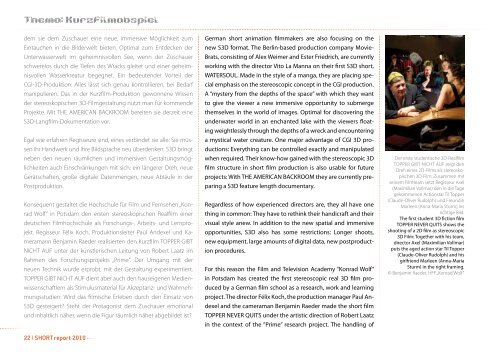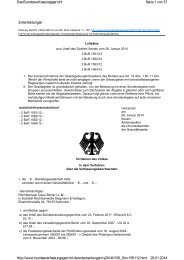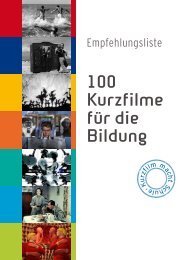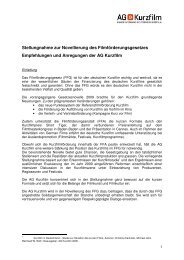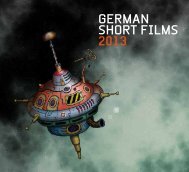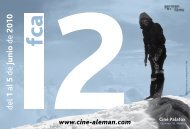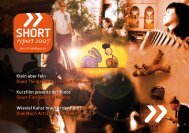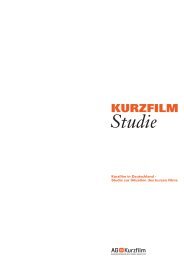short report - AG Kurzfilm
short report - AG Kurzfilm
short report - AG Kurzfilm
Erfolgreiche ePaper selbst erstellen
Machen Sie aus Ihren PDF Publikationen ein blätterbares Flipbook mit unserer einzigartigen Google optimierten e-Paper Software.
Thema: <strong>Kurzfilm</strong>abspiel<br />
dem sie dem Zuschauer eine neue, immersive Möglichkeit zum<br />
Eintauchen in die Bilderwelt bieten. Optimal zum Entdecken der<br />
Unterwasserwelt im geheimnisvollen See, wenn der Zuschauer<br />
schwerelos durch die Tiefen des Wracks gleitet und einer geheimnisvollen<br />
Wasserkreatur begegnet. Ein bedeutender Vorteil der<br />
CGI-3D-Produktion: Alles lässt sich genau kontrollieren, bei Bedarf<br />
manipulieren. Das in der <strong>Kurzfilm</strong>-Produktion gewonnene Wissen<br />
der stereoskopischen 3D-Filmgestaltung nutzt man für kommende<br />
Projekte. Mit THE AMERICAN BACKROOM bereiten sie derzeit eine<br />
S3D-Langfilm-Dokumentation vor.<br />
Egal wie erfahren Regisseure sind, eines verbindet sie alle: Sie müssen<br />
ihr Handwerk und ihre Bildsprache neu überdenken. S3D bringt<br />
neben den neuen räumlichen und immersiven Gestaltungsmöglichkeiten<br />
auch Einschränkungen mit sich: ein längerer Dreh, neue<br />
Gerätschaften, große digitale Datenmengen, neue Abläufe in der<br />
Postproduktion.<br />
Konsequent gestaltet die Hochschule für Film und Fernsehen „Konrad<br />
Wolf“ in Potsdam den ersten stereoskopischen Realfilm einer<br />
deutschen Filmhochschule als Forschungs-, Arbeits- und Lernprojekt.<br />
Regisseur Félix Koch, Produktionsleiter Paul Andexel und Kameramann<br />
Benjamin Raeder realisierten den <strong>Kurzfilm</strong> TOPPER GIBT<br />
NICHT AUF unter der künstlerischen Leitung von Robert Laatz im<br />
Rahmen des Forschungsprojekts „Prime“. Der Umgang mit der<br />
neuen Technik wurde erprobt, mit der Gestaltung experimentiert.<br />
TOPPER GIBT NICHT AUF dient aber auch den hauseigenen Medienwissenschaftlern<br />
als Stimulusmaterial für Akzeptanz- und Wahrnehmungsstudien:<br />
Wird das filmische Erleben durch den Einsatz von<br />
S3D gesteigert? Steht der Protagonist dem Zuschauer emotional<br />
und inhaltlich näher, wenn die Figur räumlich näher abgebildet ist?<br />
22 | ShOrT <strong>report</strong> 2010 e<br />
German <strong>short</strong> animation filmmakers are also focusing on the<br />
new S3D format. The Berlin-based production company Movie-<br />
Brats, consisting of Alex Weimer and Ester Friedrich, are currently<br />
working with the director Vito La Manna on their first S3D <strong>short</strong>,<br />
WATERSOuL. Made in the style of a manga, they are placing special<br />
emphasis on the stereoscopic concept in the cGI production.<br />
A “mystery from the depths of the space” with which they want<br />
to give the viewer a new immersive opportunity to submerge<br />
themselves in the world of images. Optimal for discovering the<br />
underwater world in an enchanted lake with the viewers floating<br />
weightlessly through the depths of a wreck and encountering<br />
a mystical water creature. One major advantage of cGI 3D productions:<br />
Everything can be controlled exactly and manipulated<br />
when required. Their know-how gained with the stereoscopic 3D<br />
film structure in <strong>short</strong> film production is also usable for future<br />
projects: With THE AMERIcAn BAcKROOM they are currently preparing<br />
a S3D feature length documentary.<br />
Regardless of how experienced directors are, they all have one<br />
thing in common: They have to rethink their handicraft and their<br />
visual style anew. In addition to the new spatial and immersive<br />
opportunities, S3D also has some restrictions: Longer shoots,<br />
new equipment, large amounts of digital data, new postproduction<br />
procedures.<br />
For this reason the Film and Television Academy “Konrad Wolf”<br />
in Potsdam has created the first stereoscopic real 3D film produced<br />
by a German film school as a research, work and learning<br />
project. The director Félix Koch, the production manager Paul Andexel<br />
and the cameraman Benjamin Raeder made the <strong>short</strong> film<br />
TOPPER nEVER QuITS under the artistic direction of Robert Laatz<br />
in the context of the “Prime” research project. The handling of<br />
Der erste studentische 3D-Realfilm<br />
TOPPER GIBT NICHT AUF zeigt den<br />
Dreh eines 2D-Films als stereoskopischen<br />
3D-Film: Zusammen mit<br />
seinem Filmteam setzt Regisseur Axel<br />
(Maximilian Vollmar) den in die Tage<br />
gekommenen Actionstar Til Topper<br />
(Claude-Oliver Rudolph) und Freundin<br />
Marleen (Anna-Maria Sturm) ins<br />
richtige Bild.<br />
The first student 3D fiction film<br />
TOPPER nEVER QuITS shows the<br />
shooting of a 2D film as stereoscopic<br />
3D Film: Together with his team,<br />
director Axel (Maximilian Vollmar)<br />
puts the aged action star Til Topper<br />
(claude-Oliver Rudolph) and his<br />
girlfriend Marleen (Anna-Maria<br />
Sturm) in the right framing.<br />
© Benjamin Raeder, HFF „Konrad Wolf“


